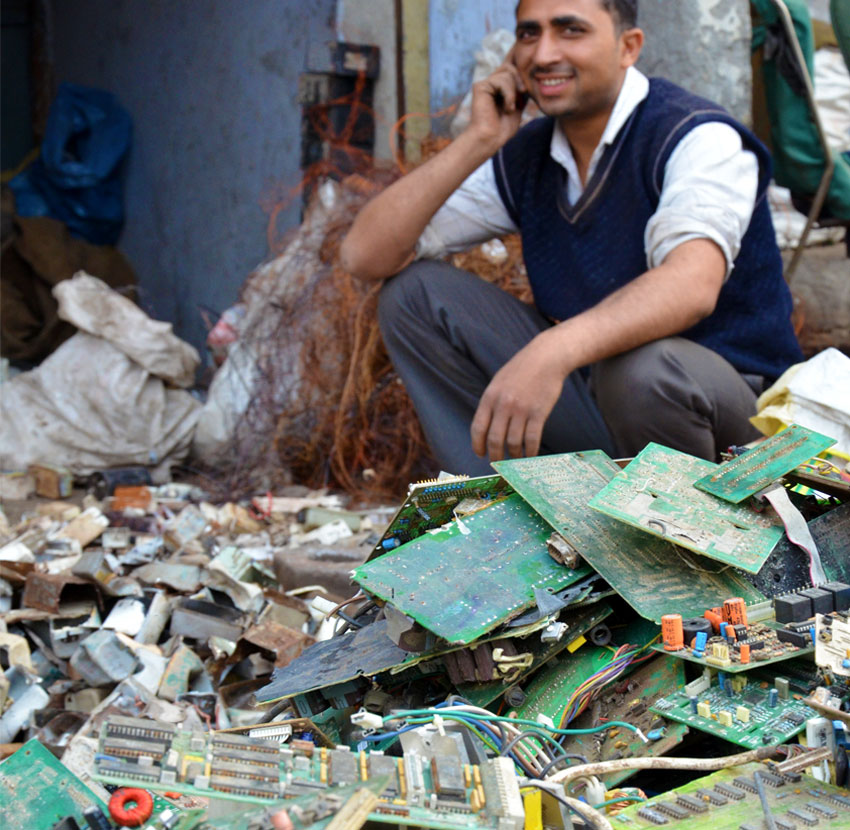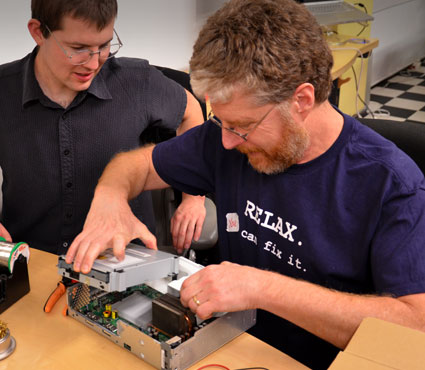Elektronik Üretimi Dünyada Her Gün Bir Delik Açıyor
Kısa ömürlü ürünler için yapılan maden kazıma işlemlerinin uzun vadeli sonuçları olur
 Bir dizüstü bilgisayarın hayatı boyunca kullanacağı enerjinin
Bir dizüstü bilgisayarın hayatı boyunca kullanacağı enerjinin % 81'i
tüketicinin kullanımı esnasında değil, cihazın üretimi sırasında harcanıyor.

91 ton
Elektronikte malzemeler için yapılan kazı çalışmaları inanılmaz derecede yıkıcı. Topraktan bir ons altının çıkarılması 91 tona kadar atık üretilmesine sebep olabiliyor.

Dünyadaki tenekenin 1/3'i,
Endonezya'nın Bangka adalarındaki gayri resmi madenlerden geliyor. Bu madenler o kadar kötü işletiliyor ki, toprak kaymasından nerdeyse her hafta bir işçi ölüyor.

Dünya tantal rezervlerinin yarısı
televizyon ve tablet gibi selektronik üretimleri yapımında kullanılmak üzere satılıyor; bunun bir kısmı da Afrika'daki iç savaşı fonluyor.
Eşyalarımızı üretmek, şaşırtıcı miktarda hammadde gerektirir.
Ağırlık hesabı yapıldığında elektronikler, diğer tüm ürünlerden çok daha fazla kaynak gerektirir.
4.5 onsluk iPhone'un 295 librelik ham madde ihtiyacı olur (metal + su). Havalı cihazlara olan talebi karşılayabilmek için geçtiğimiz son 10 sene içersinde demir üretimi % 126 , kobalt üretimi % 151 ve lityum üretimi % 172 arttı.
Ama kazıp çıkarabileceğimiz rezervler tükeniyor.
Üreticiler her yıl toprağın daha derinlerine inerek daha az hammaddeyle daha fazla atık üretmek zorunda kalıyor. Bakır cevheri yatakları, 100 yıl önce çıkarılan cevherin onda biri saflığındadır. Altın getirileri son altı yılda yüzde 23 düştü.
Madenciliğin maliyetini dolar olarak değil, can olarak ölçüyoruz.

Kaliforniya'daki bir nadir toprak madeni Mojave Çölü'ne 300.000 galon radyoaktif atık döktü ve nadir toprak madenleri Malezya'daki yeraltı suyunu kirletmeye ediyor.

Hem Samsung hem de Apple, madencilerinçöken ölümcül Endonezya kalay madenlerinden kalay kullandıklarını doğruladılar.

Koltan hemen hemen her elektronik ortamda bulunmaktadır ve dünyadaki koltan rezervlerinin % 80'i savaşın harap ettiği Demokratik Kongo Cumhuriyeti'nde bulunmaktadır. Bugün madenlerde en küçükleri sekizkadar çalışıyor.

2017 yılında Toshiba, çatışma minerallerinin izlenmesi söz konusu olduğunda , en kötü tüketici elektroniği şirketi, olarak sıralandı.

Üretim bize kaynaklara ve enerjiye mal olur.
Elektronik eşyalar göremediğimiz bagajlarla birlikte gelir. 129 gramlık bir üretimi için ağırlığın%21000 katı malzeme gerekir. (100 litre su + 75 pound cevher).
Bir masaüstü bilgisayar yapmak için %1530 pound fosil yakıt gerekir.
Mikroçipler her şeyin içindedir; bilgisayarlarda, arabalarda, hatta buzdolaplarında. Ancak bu minik çipleri yapmak sandığınızdan daha pahalıya mal oluyor. Tek bir mikroçip oluşturmak için yaklaşık 70 pound su ve arsenik dahil yüzlerce kimyasalgerekir; cep telefonunuzda bunlardan onlarca var.
Mikroçiplerin üretilmesi, yüksek teknoloji endüstrisinin kalbi olan Silikon Vadisi'ni ABD'nin en kirli bölgelerinden biri haline getirdi.

Tamir, ürünlerin daha uzun süre dayanmasını sağlar.
Tamir edilen her cep telefonu, üretilmesi gereken bir telefon eksiğidir. Yalnızca bir yıl daha uzun süre kullanılan her dizüstü bilgisayar, sınırlı kaynaklarımız üzerindeki yükü azaltır. Yükseltilen her bilgisayar, gerçekten değiştirilmesi gerekmeden önce ikinci, üçüncü ve hatta dördüncü bir kullanıcıya geçebilir.
Mümkün olduğunda onarılabilir elektronik cihazlar satın alın. Telefonunuzu ve bilgisayarınızı yıprandıklarında onarın. Daha sonra bunları kullanmaya devam edin veya başkalarına verin.
En yeşil telefon zaten cebinizde olan telefondur.
Madencilik ve imalat yıkımdır. Ürünlerin daha uzun süre dayanmasını sağlamak mantıklıdır; onarım ve yeniden kullanım bizim geleceğimizdir.
Daha Fazla Bilgi Edinin
Onarılabilir tasarım nedir?
Elektronik ürünlerimizdeki çatışma mineralleri Kongo'daki savaşları .
Çin, nadir toprak madenciliği arzına hakim durumda, ancakmaden bunu değiştirmeye çalışıyor.
Harekete Geç
Mümkün olduğunda elektronik cihazlarınızı onarın. Makinenin çoğu hala iyi çalışıyorsa yeni bir tane almanıza gerek yok.
Araştırma: Satın almadan önce hangi telefonlarınve tamir edilebilir olduğunu öğrenin.